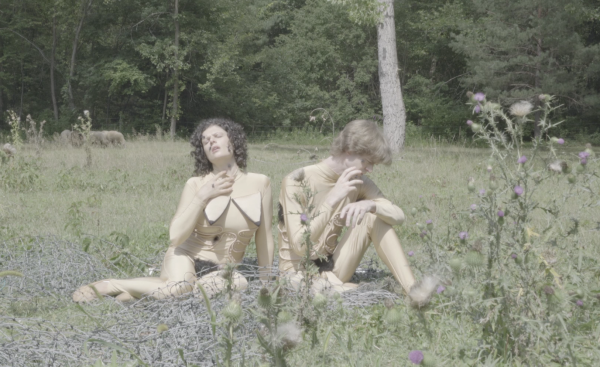The critical blog romanovgrave.com/studio-visits/lenore-malen recently posted an essay on Scenes From Paradise: a series of 3 channel videos and a film (2016). Their essay ranged widely from politics to film and expands greatly on previously written posts on this site. A still from the film is shown here. (The web version of the essay (see link above) has numerous pictures that illuminate the text.)
New York City, Central Park. Four animals, a horse, a goat, a lion and perhaps a Dalmatian, make their way as a team, seeming to rappel without ropes, across a rocky outcrop of 450 million year old schist rock. The blocking of the figures evokes the dance of death scene from Bergman’s The Seventh Seal. The pinstripe skyscrapers in rear bring to mind Hitchcock’s North by Northwest. The setting, Central Park, deploys, tragically, Olmsted’s culture performed as nature. We would do well to remember that Bergman staged his opus as a chess game between a returning crusader and the figure of Death as the bubonic plague ravaged Europe; that Hitchcock invented for his film a compass point that simply does not exist, while, with Olmstead, nature is nothing more than an echo of an anthropomorphized projection. As we sift and connect these dots, as we do for the above the very messy calculus we all know this will not turn out well. An end game is in at hand.
Approached in medias res in the studio this is an initial take on Lenore Malen’s current project, a multi layered and multi part film project titled Scenes From Paradise. Screened for us by the artist in her studio, provisionally arranged as a three-monitor installation, the work unconsciously, unknowingly, came to resemble the three altars of a place of Catholic worship. (Maybe prayer can save us, but we have our doubts.) The entire project has evolved over the past two and a half years out of Malen’s chance discovery, as she browsed the web, of a medieval manuscript illumination. The artist of that illumination, The Maître Francois, worked in the service of The Duke of Nemours, producing the rarified knowledge of the less literate, but in its own way knowledge filled, 15th century. Continue Reading